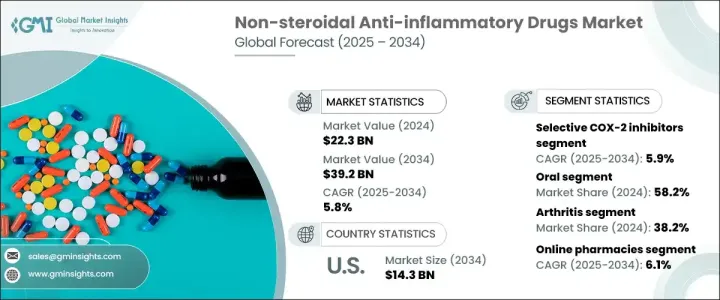
세계의 비스테로이드성 항염증제 시장 규모는 2024년 223억 달러로 평가되었고, 2025년부터 2034년까지 연평균 성장률(CAGR) 5.8%로 성장할 것으로 예상됩니다. 이러한 약물의 수요 증가는 지속적인 관리가 필요한 관절염, 근골격계 질환, 요통을 비롯한 만성 통증 질환의 유병률이 증가함에 따라 크게 증가하고 있습니다. 전 세계 인구가 계속 고령화됨에 따라 NSAID의 필요성은 더욱 커지고 있습니다.

최근 몇 년 동안 시장은 효과적이면서도 위장에 부담이 적은 약물로 전환하는 추세를 보이고 있습니다. 선택적 COX-2 억제제는 2034년까지 5.9%의 연평균 성장률이 예상되는 NSAID 시장에서 가장 빠르게 성장하는 부문이 될 것으로 예상됩니다. 이러한 약물은 주로 염증과 통증을 유발하는 COX-2 효소를 표적으로 하며 비선택적 COX 억제제에서 흔히 볼 수 있는 위장 문제를 최소화합니다.
| 시장 범위 | |
|---|---|
| 시작 연도 | 2024년 |
| 예측 연도 | 2025-2034년 |
| 시작 금액 | 223억 달러 |
| 예측 금액 | 392억 달러 |
| CAGR | 5.8% |
투여 경로별로 볼 때 경구용 부문이 2024년 58.2%로 가장 큰 시장 점유율을 차지할 것으로 예상됩니다. 경구용 NSAID는 사용 편의성, 비용 효율성, 광범위한 가용성으로 인해 급성 및 만성 통증을 관리할 수 있는 솔루션으로 선호되고 있습니다. 특히 매일 약물을 복용해야 하는 질환에 사용할 때 환자와 의료진에게 편리함을 제공합니다.
2034년까지 미국 NSAID 시장은 143억 달러에 달할 것으로 예상됩니다. 그 결과, 미국은 전 세계 NSAID 시장 확대에 중추적인 역할을 할 것으로 전망됩니다. 효과적인 항염증 치료제에 대한 필요성이 계속 증가함에 따라 약물 제형에 대한 추가 혁신의 문이 열릴 것입니다.
결론적으로, 인구통계학적 변화, 만성 통증 유병률 증가, 약물 개발의 기술 발전 등이 복합적으로 작용하여 NSAID 시장은 꾸준하고 지속적인 성장세를 보일 것으로 전망됩니다. 새로운 제형이나 개선된 전달 방법을 통해 NSAID 치료제의 혁신 기회는 계속해서 시장의 미래를 형성할 것입니다.
The Global Non-Steroidal Anti-Inflammatory Drugs Market was valued at USD 22.3 billion in 2024, with expectations to expand at a robust CAGR of 5.8% from 2025 to 2034. NSAIDs are widely recognized for their effectiveness in reducing inflammation, alleviating pain, and controlling fever. They achieve this by inhibiting cyclooxygenase (COX) enzymes that produce pain-causing prostaglandins. The rise in demand for these drugs is largely driven by the increasing prevalence of chronic pain conditions, including arthritis, musculoskeletal disorders, and back pain, all of which require ongoing management. As the global population continues to age, the need for NSAIDs becomes even more significant. Older adults are more susceptible to inflammatory conditions, and this demographic shift is expected to further fuel market growth.

In recent years, the market has seen an increasing shift toward drugs that are both effective and easier on the stomach. Selective COX-2 inhibitors are predicted to be the fastest-growing segment within the NSAID market, with a projected CAGR of 5.9% through 2034. These drugs target the COX-2 enzyme, which is primarily responsible for inflammation and pain while minimizing the gastrointestinal issues commonly seen with non-selective COX inhibitors. This makes selective COX-2 inhibitors a preferred choice for long-term pain management, especially in patients suffering from chronic conditions such as osteoarthritis and rheumatoid arthritis.
| Market Scope | |
|---|---|
| Start Year | 2024 |
| Forecast Year | 2025-2034 |
| Start Value | $22.3 Billion |
| Forecast Value | $39.2 Billion |
| CAGR | 5.8% |
Looking at the route of administration, the oral segment holds the largest market share, capturing 58.2% in 2024. Oral NSAIDs are favored for their ease of use, cost-effectiveness, and wide availability, making them the go-to solution for managing both acute and chronic pain. They offer convenience for patients and healthcare providers, particularly when used for conditions that require daily medication.
The U.S. market for NSAIDs is expected to reach USD 14.3 billion by 2034. This growth is driven by the aging population, which is rapidly increasing and creating a growing demand for treatments for age-related inflammatory diseases. As a result, the U.S. is set to play a pivotal role in the expansion of the global NSAID market. As the need for effective anti-inflammatory treatments continues to rise, this will open doors for further innovations in drug formulations.
In conclusion, the NSAID market is set for steady and sustained growth, fueled by a combination of demographic shifts, the increasing prevalence of chronic pain, and technological advancements in drug development. Whether through new formulations or improved delivery methods, opportunities for innovation in NSAID treatments will continue to shape the market's future.